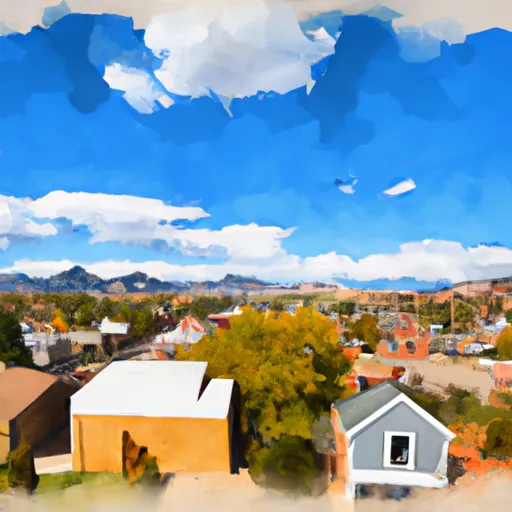-
 Snoflo Premium
Snoflo Premium
Get unlimited access to all our content
With no Ad interruptions! - Start Your Free Trial Login with existing account
Stoneham
Eden Index
Climate
8.2
•
Recreation
•
Community
•
Safeguard
3.3/10

Stoneham is a small town located in northeastern Colorado, known for its picturesque landscapes and abundance of outdoor recreation opportunities. The climate in Stoneham is classified as a semi-arid region, characterized by hot summers and cold winters. Precipitation is relatively low, averaging around 15 inches per year, with most of it occurring during the summer months in the form of thunderstorms.
Hydrologically, Stoneham sits within the South Platte River Basin. The area is dotted with small creeks and streams that contribute to the hydrological makeup of the region. These water sources provide essential irrigation for agricultural activities and support local wildlife.
Outdoor enthusiasts will find numerous recreational opportunities in Stoneham. The surrounding area offers vast expanses of open space, perfect for hiking, camping, and bird-watching. The Pawnee National Grassland, located nearby, is a popular destination for off-road vehicle enthusiasts and offers excellent opportunities for wildlife viewing. Fishing enthusiasts can enjoy casting their lines in nearby reservoirs and lakes, such as North Sterling State Park.
In summary, Stoneham, Colorado boasts a semi-arid climate, hydrologically influenced by the South Platte River Basin. The region provides a plethora of outdoor recreation opportunities, including hiking, camping, off-road vehicle riding, bird-watching, and fishing.
What is the Eden Index?
The Snoflo Eden Index serves as a comprehensive rating system for regions, evaluating their desirability through a holistic assessment of climate health, outdoor recreation opportunities, and natural disaster risk, acknowledging the profound impact of these factors on livability and well-being.
Climate Health Indicator (CHI): 8.2
Stoneham receives approximately
382mm of rain per year,
with humidity levels near 78%
and air temperatures averaging around
10°C.
Stoneham has a plant hardyness factor of
5, meaning
plants and agriculture in this region thrive during a short period during spring and early summer. Most
plants will die off during the colder winter months.
By considering the ideal temperature range, reliable water supplies, clean air, and stable seasonal rain or snowpacks, the Climate Health Indicator (CHI) underscores the significance of a healthy climate as the foundation for quality living.
A healthy climate is paramount for ensuring a high quality of life and livability in a region, fostering both physical well-being and environmental harmony. This can be characterized by ideal temperatures, reliable access to water supplies, clean air, and consistent seasonal rain or snowpacks.
Weather Forecast
Streamflow Conditions
South Platte
Area Rivers
South Platte
Snowpack Depths
South Platte
Reservoir Storage Capacity
South Platte
Groundwater Levels
Recreational Opportunity Index (ROI):
The Recreational Opportunity Index (ROI) recognizes the value of outdoor recreational options, such as parks, hiking trails, camping sites, and fishing spots, while acknowledging that climate plays a pivotal role in ensuring the comfort and consistency of these experiences.
Access to outdoor recreational opportunities, encompassing activities such as parks, hiking, camping, and fishing, is crucial for overall well-being, and the climate plays a pivotal role in enabling and enhancing these experiences, ensuring that individuals can engage in nature-based activities comfortably and consistently.
Camping Areas
| Campground | Campsites | Reservations | Toilets | Showers | Elevation |
|---|---|---|---|---|---|
| Riverside RV Park | 25 | 4,266 ft | |||
| Gotte Park | None | 4,715 ft | |||
| Oliver Reservoir State Rec Area | 175 | 4,812 ft | |||
| Brush Memorial RV Park | 24 | 4,235 ft |
Nearby Fishing
Catastrophe Safeguard Index (CSI):
The Catastrophe Safeguard Index (CSI) recognizes that natural disaster risk, encompassing floods, fires, hurricanes, and tornadoes, can drastically affect safety and the overall appeal of an area.
The level of natural disaster risk in a region significantly affects safety and the overall livability, with climate change amplifying these risks by potentially increasing the frequency and intensity of events like floods, fires, hurricanes, and tornadoes, thereby posing substantial challenges to community resilience and well-being.
Community Resilience Indicator (CRI):
The Community Resilience Indicator (CRI) recognizes that education, healthcare, and socioeconomics are crucial to the well-being of a region. The CRI acknowledges the profound impact of these elements on residents' overall quality of life. By evaluating educational resources, healthcare accessibility, and economic inclusivity, the index captures the essential aspects that contribute to a thriving community, fostering resident satisfaction, equity, and social cohesion.

